This is a Japanese version of Egg Drop Soup called Kakitama-jiru. Kakitama-jiru broth is based on dashi stock, but Chinese egg drop soup is made with chicken stock. Fluffy eggs in the soup look almost like ribbons.
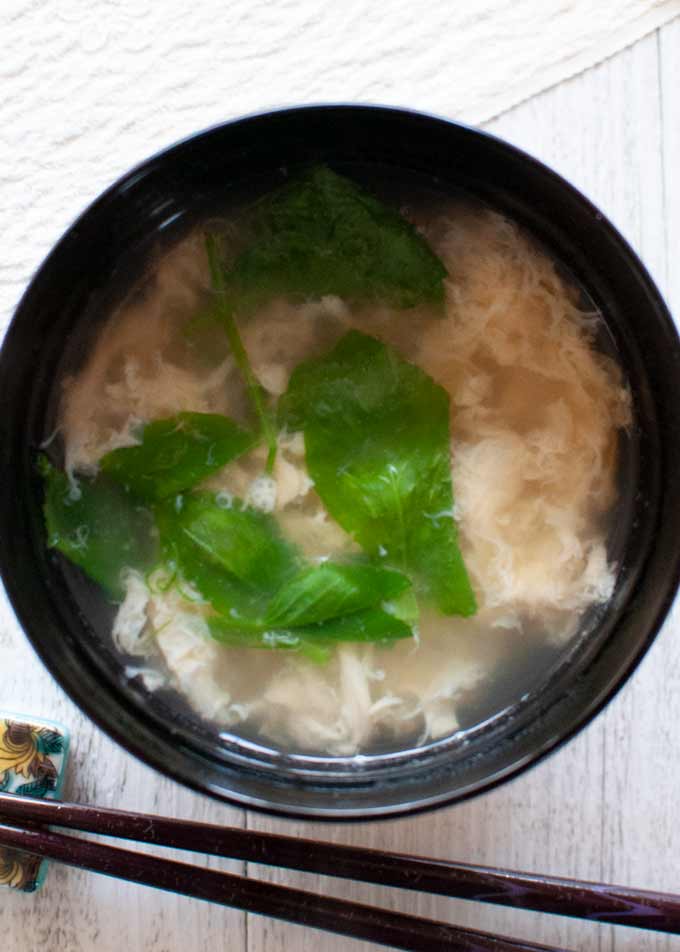
The Japanese name of this soup, ‘Kakitama-jiru’ (かきたま汁), does not translate to Egg Drop Soup. The English name perhaps came from the action of dropping beaten eggs into the hot broth. On the other hand, the name of the Japanese dish is more focused on the action after dropping the beaten eggs into the broth, i.e. stirring the eggs.
Stir is ‘kakimazeru’ (かき混ぜる) and egg is ‘tamago (たまごor 卵) in Japanese and the first two syllables of each word were taken to make up ‘kakitama’ (かきたま). ‘Jiru’ (汁) means soup or broth.
Simple Broth
The broth is made of dashi stock with a small amount of light soy sauce and salt.
Some recipes also add a small amount of sake to it. But if you make dashi stock from scratch as per my post, Home Style Japanese Dashi Stock, I don’t think you need to add sake at all.
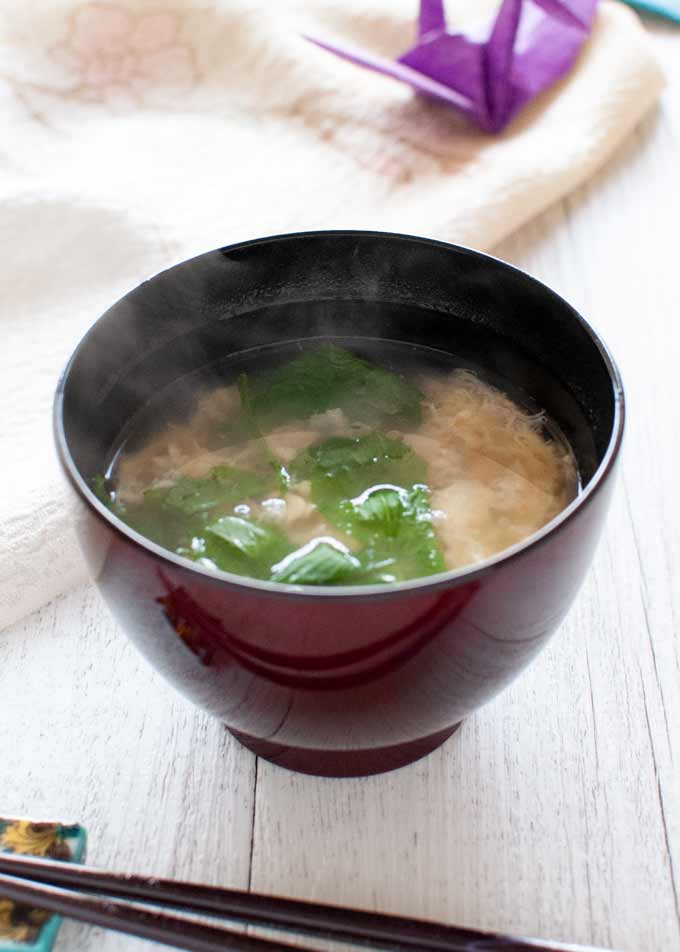
It is a clear soup with a slight saltiness and it’s full of dashi flavour. The broth is also slightly thickened with cornflour/corn-starch. Thickening the broth has two purposes:
- Keeps the soup warm for a long time.
- Prevents the egg from sinking to the bottom quickly when cooking, which makes the cooked eggs fluffier.
Other than the broth, you only need egg and some greens as garnish.
Cooking Eggs
This is a very simple soup to make that takes only 5 minutes or so to cook. However, the simple things are often difficult to master to perfection and this soup is just like that. The perfect Kakitama-jiru should have ribbon-like eggs and the soup should be clear.
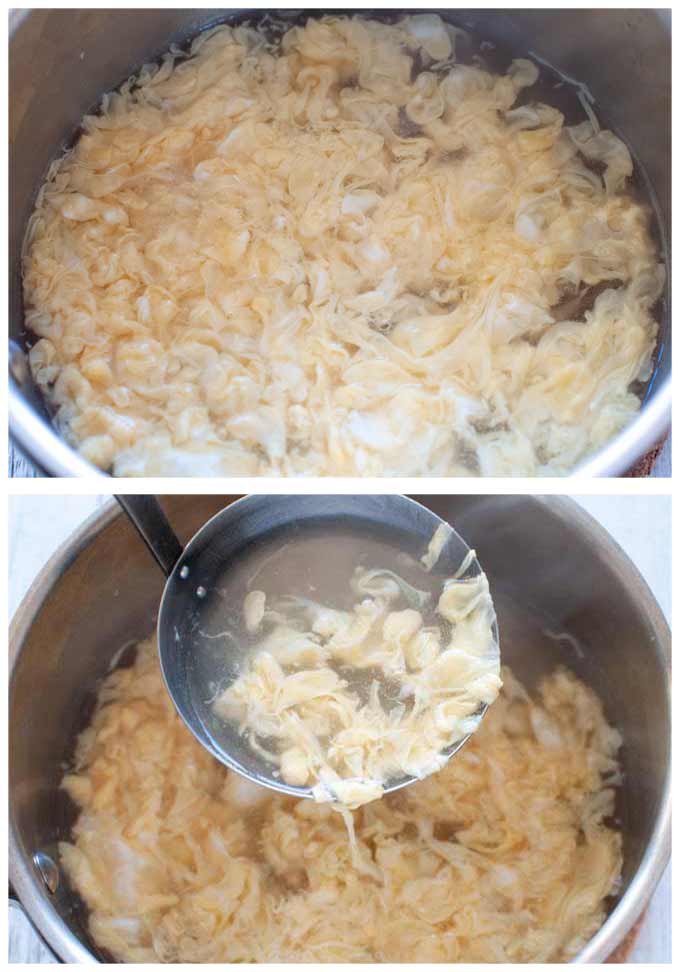
I said earlier that the Japanese name of this dish, Kaikitama-jiru came from how you stir the egg into the broth. Interestingly, you will learn how not to ‘stir’ the eggs and keep the soup clear from the tips below.
- Boil the broth and thicken it with cornflour/cornstarch. Thickened broth helps the eggs float, preventing it from quickly reaching to the bottom of the pot.
- Reduce the heat to medium so that the broth is boiling but not vigorously. Boiling too rapidly makes the egg to break into small pieces. Not enough boiling makes the egg sink too fast before getting cooked.
- Using chopsticks or a fork, pour the beaten eggs into the broth along the chopsticks/fork, drawing a circle starting from the centre towards the outer edge. If you have a ladle with small round holes, you could pour the egg through it instead.
- After you have added all the egg to the broth, gently stir the egg with a ladle.
Greens for Garnish
Kakitama-jiru is tasty with just fluffy eggs in delicately flavoured broth. But if you add some green leaves to it, it becomes pretty and more appetizing.
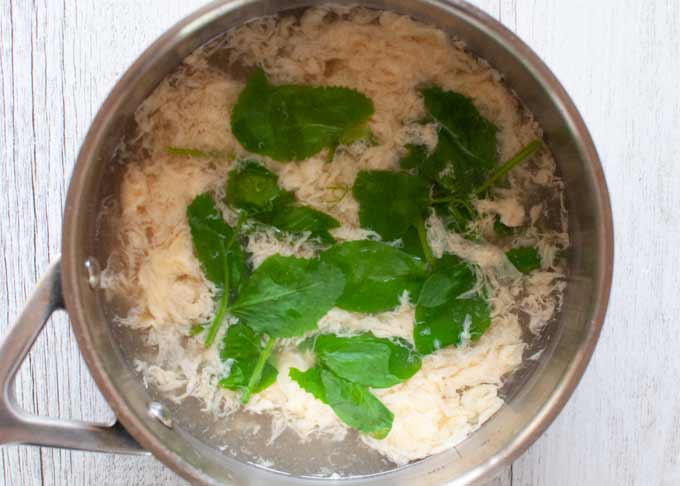
The most commonly used green leaf for Kakitama-jiru in Japan is mitsuba (三つ葉, a wild Japanese parsley or the Japanese version of Cryptotaenia), which is a Japanese herb that looks like large flat leaf parsley and has a distinct flavour unlike any other herb.
It is not easy to find mitsuba here in Sydney so I often substitute it with snow pea shoots, mizuna, finely chopped shallots/scallions or baby spinach. Today, I used snow pea shoots.
The green leaves should be cut to about 2.5cm/1” long except shallots/scallions that should be finely chopped. You only need a small amount.
Instead of green leaves, some recipes add wakame seaweed or thinly sliced shiitake mushrooms to it. You can be creative and add other leaves or vegetables but make sure that they are not too thick or too large.
The recipe makes enough soup for two standard Japanese soup bowls. But you could double the quantity and serve like a Western-style soup (photo below).
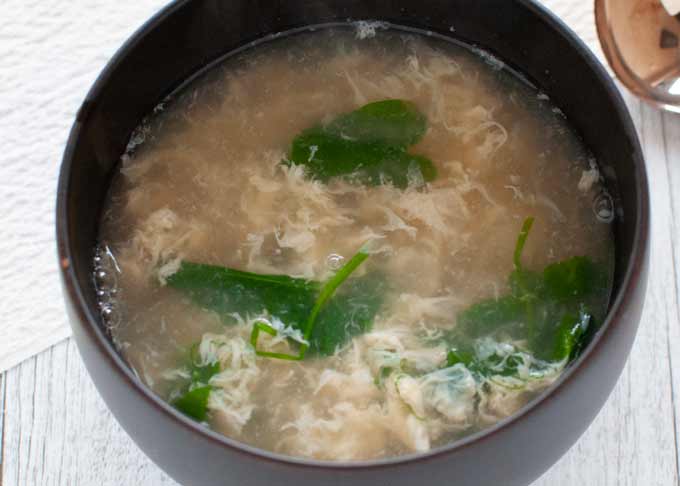
Yumiko![]()
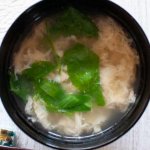
This is a Japanese version of Egg Drop Soup called Kakitama-jiru. Kakitama-jiru broth is based on dashi stock, but Chinese egg drop soup is made with chicken stock. Fluffy eggs in the soup look almost like ribbons. It also reheats well.
Cook Time does not include the time to make dashi stock.
- 400ml / 0.8pt dashi stock (note 1)
- 1 tsp light soy sauce (note 2)
- ⅓ tsp salt
- 3 tsp cornflour/corn-starch diluted in 3 tsp water (note 3)
- 1 egg , beaten
- A handful of snow pea shoots cut to 2.5cm/1” pieces (note 4)
-
Bring dashi stock to a boil and add soy sauce and salt.
-
When salt is dissolved, add the cornflour to the broth slowly while mixing the broth with a ladle. This prevents cornflour lumps in the broth.
-
When the broth thickens, reduce the heat to medium so that the broth is gently boiling.
-
Using chopsticks or a fork, pour the beaten egg along the chopsticks/fork, drawing a circle starting from the centre of the pot towards the outer edge (note 5).
-
Gently stir the egg ribbons with the ladle, then turn the heat off.
-
Add the snow pea shoots to the soup and serve while hot (note 6).
1. I strongly recommend home-made dashi stock if you have time and access to dried bonito flakes. The broth is seasoned very lightly and you are meant to enjoy the great flavour of dashi.
If you need to use an instant dashi pack or granular dashi powder to make dashi stock, reduce the salt to ¼ tsp or less depending on the type of dashi pack. The granular dashi powder contains the most salt. Taste and adjust when seasoning the broth.
2. You can substitute light soy sauce with normal soy sauce. The colour of the broth becomes marginally darker if normal soy sauce is used. You may also need to adjust the amount of salt as normal soy sauce is slightly less salty than light soy sauce.
Dark soy sauce is not suited for this recipe.
3. The amount of cornflour/corn-starch can be anywhere between 2 to 4 teaspoons depending on how thin/thick broth you want.
4. I picked only the tip of the snow pea leaves to avoid thick stems.
The most commonly used garnish in Japan is mitsuba - a wild Japanese parsley or the Japanese version of Cryptotaenia. You can also use mizuna, baby spinach or finely chopped shallots/scallions.
This is for a garnish and you don’t have to have it, although the green makes the soup look prettier.
5. If you have a ladle with small holes, you could pour the egg through it instead of using chopsticks/fork.
6. When transferring the soup from the pot to a serving bowl, gently scoop the soup and try not to break eggs into smaller pieces.
7. The serving size is the size of a typical Japanese soup bowl. If you would like the soup to be served like a Western-style soup in a larger soup bowl, you will need to double the quantity.
Do you have a cookbook I could buy? Thanks
Hi Christina, no I don’t. but at some stage when I feel that I posted sufficient varieties of dishes, I might produce an ebook.